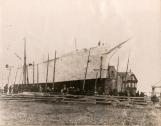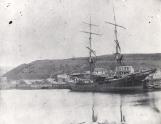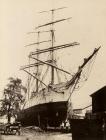1
The Ship Building IndustryShipbuilding was one of the most important industries in Albert County during the nineteenth century. Following the Napoleonic Wars of the early 1800's, England was cut off from its supply of timber. Britain looked to its colony in North America to secure a steady supply of wood. Albert County with its hills full of virgin timber surrounded by rivers which flow out into the Bay of Fundy was an ideal location to fill this demand. As the timber was being cut down and turned into lumber demand for vessels to transport the lumber increased. Once again the geography of Albert County proved to be an asset in helping to fill this demand. Albert County not only had a readily available supply of timber for building ships but also had many low lying areas close to the Bay where ships could be built. The early settlers had built dykes to keep the tide water off the low lying marsh lands. However, these same flat lands located next to the Bay were an excellent place to build and launch ships into the sea. Ships were built at seemingly every creek and low lying area along the Petitcodiac river and Bay of Fundy from Salisbury to Point Wolfe. There are at least 23 locations where ships were known to have been built. At one time the Gunningsville bridge between Riverview and Moncton had one section of the bridge which rotated to allow tall ships to sail through the bridge. Most of the ships built in Albert County were not the large ships we see in movies but smaller two masted vessels. Often the ships were built by the men who owned the lumber mills because they believed that having their own ships to haul their products to market would save them money. The expansion of the United States, the gold rush in California, and the opening of markets in Africa and the Far East also greatly increased the need for more ships. Many vessels built in Albert County were used to transport goods to and from markets around the world. Indeed many local men from Albert County went off in search of adventure sailing around the world.
2
The Ship Stadium, docked at an unidentified wharf near Alma.19 September 1910
Alma, New Brunswick, Canada
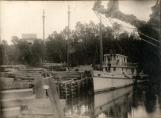
3
This view of the harbour in Alma shows the tugboat Stadium lining up three vessels at the dock.19 September 1910
Alma, New Brunswick, Canada
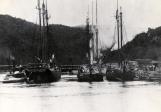
4
The harbour in Alma, Pictured is the tugboat Stadium beside two vessels tied to the dock.19 September 1910
Alma, New Brunswick, Canada
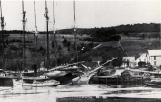
6
The owners of these ships were mostly prominent local businessmen who hired Master Shipbuilders to manage their shipyards for them. When a new ship was ordered the Master shipbuilder would start by making a half-model.7
Shipbuilders half model of the ship P.I. Nevis built at Bennett shipyards in Hopewell Cape in 1858.15 September 1858

8
The half-model was a scale representation of the hull of the ship. Today we would do this design on a computer or drafting paper. It must be remembered that the shape of the hull greatly effected the speed of the ship and how much cargo the ship could carry. Since there were no standards for designing and building a ship, few schools one could attend to learn the craft, and no standard design plans a shipbuilder could follow when building a ship, each shipbuilder had to rely on his previous shipbuilding experience. A Master Shipbuilder knew how to take what he had learned about how the size and shape of a ship's hull effects how much the vessel can carry, and how fast it can travel, and use this knowledge to help him design a ship that was faster and could carry more cargo than any other vessel at sea. After the master builder had finished designing a hull for the ship, that would best suit the needs of the client, the half-model would be taken apart and the pieces drawn on paper. Next the drawings would be done to full scale and drawn on the floor. Then the frames of the side of the hull were constructed from those drawings, hoisted into place and secured to the keel. The keel was a series of long timbers which ran along the bottom of the vessel from stem to stern. After the frames of the hull were in place scaffolding would be built around the ship and planks would be put on the hull.9
The Meredith White and its sister ship, the Vincent, under construction in Alma in 1918.19 September 1918
Alma, New Brunswick, Canada
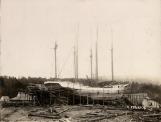
10
This photo shows two ships the Vincent and Meredith White being built side by side in Alma in 1918.19 September 1918
Alma, New Brunswick, Canada
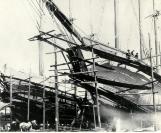
11
Workmen started planking from both the top and bottom of the vessel and met in the middle. The space in between the planks was caulked with oakum to make the ship waterproof. Then the ship was painted with a special paint that prevented wood rot and helped prevent barnacles from sticking to the hull of the ship. Next the deck and deck houses would be added. Finally the masts of the ship would be raised, this was often done in other larger ports.Over 330 wooden vessels were built in Albert County, the actual number is not known since most of the ships built were either not registered or the records have been lost. The first recorded ship built in the area was the "Good Brig" built in 1793 by John Polley of Hopewell Hill. The largest number of shipyards in the County were located in Hopewell Cape along a three kilometer stretch of marshland on the banks of the Petitcodiac River. By 1874 the Hopewell Cape area accounted for 52% of the ship tonnage produced in the county. Bennetts, Pyes, Calhouns, Newcombs; all of these are important names in the history of shipbuilding in Albert County. Together or separately members of these families built many ships at many locations along the shores of the Petitcodiac River in Hopewell Cape. Some of the members of these families would become Master Shipbuilders including Herbert Newcombe who built the world famous ship the "Roosevelt" which Admiral Peary used to voyage to the North Pole. The census records of Hopewell Cape show that many others from the area became Captains and Seaman. The last vessel built in Hopewell Cape was a small steamer built by Capt. Warren Dixon in 1903, it had just been painted and was ready for launch when it was destroyed by a forest fire.
Most of the ship builders in Albert County built small ships weighing around 1000 tons. The exception was Gaius Turner of Harvey who built much larger vessels.
12
The vessel the Revolving Light while under construction at the Turner Shipyards in Harvey in 1875.19 September 1875
Harvey, New Brunswick, Canada
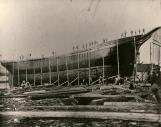
13
The launch of the Edna M. Smith the last ship built at the Turner Shipyards in Harvey Bank, in 1903.19 September 1903
Harvey, New Brunswick, Canada
